The 5 types of ANIMAL RESPIRATION

In the animal Kingdom can be found very varied living beings, which are adapted to a large number of different media. One of the most important characteristics when it comes to being well adapted to the environment is to "devise" an effective and efficient way of breathing. A fish does not breathe in the same way as a mammal, but what about other animals? Do all animals breathe?
But what is breath? which are the types of animal respiration What can we find? What animals do each of them have? If you want to know more about breathing, keep reading this lesson from a TEACHER!
Index
- The process of respiration
- Direct diffusion respiration
- Skin respiration
- Branchial respiration
- Lung respiration
- Tracheal breathing
The process of respiration.
The breathing is the process by which a living being carries out a gas exchange: the oxygen uptake and carbon dioxide removal. This process takes place throughout the entire evolutionary scale: from the most primitive single-celled animals to the most complex animals, such as man.
Each animal has a own and own environmental conditions to which the respiratory system must adapt. For example, in more complex animals, the respiratory system it must have a higher performance, since the animal's gas requirements will be higher. That is why, as we will see below, animals have developed several different mechanisms and structures to breathe.
When studying respiration, you must have the following consideration: the term respiration applies to two separate biological processes. On the one hand, the term respiration can refer to the chemical process of energy release after the metabolism of organic compounds, a process that is called internal respiration or cellular respiration. On the other hand, we can call breathing, specifically external respiration, to the process of gas exchange between the body and its external environment.
Direct diffusion respiration.
Within the types of animal respiration we find direct diffusion respiration, which is the most primitive type of respiration that can occur in an animal organism. In it, gas exchange occurs directly between the environment and cells of the organism, without the appearance of respiratory organs specialized in this task.
Direct diffusion respiration is possible, since the oxygen concentration is higher in the middle than inside the animal. So, in a "natural" way and without having to force or invest energy in it, oxygen enters through the membranes of the cells that form the outer layer of the animal. Carbon dioxide is expelled in the same way: when it is generated inside the animal cell too much carbon dioxide, this goes out to the external environment until the amount in both balances sites.
Animals with direct diffusion respiration
This type of breathing is typical of porifers (sea sponges), cnidarians (hydras and jellyfish), flatworms and nematodes. In sponges, for example, cells called choanocytes appear. The choanocytes move continuously, causing the oxygen-rich external water to flow permanently close to the animal's body. In this way, the oxygen supply from the outside is maintained, ensuring that diffusion continues.
These animals are characterized by having a body wall with a thickness of few cell layers (such as porifers) or simply need little oxygen to maintain themselves (nematodes). In addition, all of them live in an aquatic habitat, either marine or freshwater, since the exchange of gases by direct diffusion is much more effective between the body and water than between the body and the air.
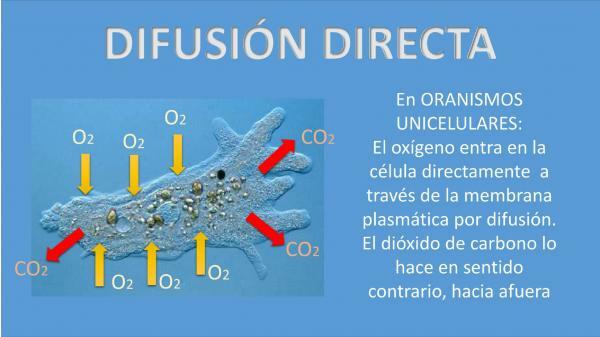
Cutaneous respiration.
The skin respiration It is also a very characteristic breathing mechanism of aquatic animals. In it, the gas exchange takes place through the skin: the body integument.
To be carried out in a practical way, the skin must be very thin, moist and highly irrigated by blood vessels, which allow oxygen to be transported to all cells of the body through the blood. Skin respiration can also occur in non-aquatic organisms, such as worms. In that case, the skin has to be kept moist by secreting mucus. Mucus or mucus is produced by cells interspersed between the cuboidal cells that make up the epithelial tissue: the glandular cells.
Examples of animals with skin respiration
Cutaneous respiration is very common in aquatic invertebrates, like mollusks, and in some terrestrial ones, like the earthworm and the leech. Among vertebrates it is common in some fish like eel, and their larvae, and is very characteristic of amphibians, although in this case, this type of respiration is not exclusive, but coexists with gill or lung respiration.
The breathing of some amphibians is something peculiar. Larval amphibians breathe inside the water using gills. When they reach maturity and pass into adulthood, during the metamorphosis process, they lose their gills and develop lungs to be able to breathe on land. However, in some species, the animal must return to the water to reproduce and search for food. Although the adult amphibian breathes normally through lungs, when it returns to the water to eat or reproduce, skin respiration is activated.
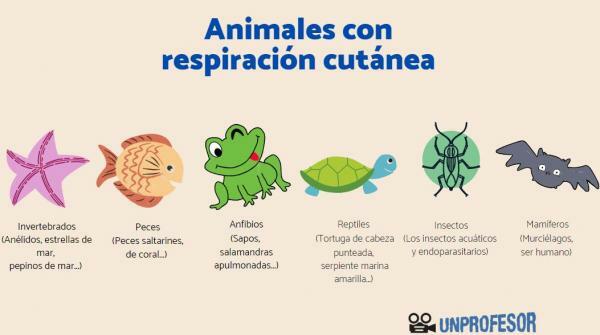
Branchial respiration.
The gill respiration It is another type of animal respiration and is typical of aquatic animals more evolved than the previous ones.
In gill breathing ya specialized organs appear in gaseous exchange: the gills or gills. The gills are tegumentary folds or very fine structures that are highly irrigated and surrounded by water. There are two types of gills: external gills, which are simply folds or folds of a part of the animal skin and are little evolved; internal gills, more evolved, since they are inside the animal's body and are more protected.
In the case of the external gills, they are unprotected, while in the internal gills they have to be developed mechanisms to change water, which gradually introduce oxygen-rich water, and which usually consume a large quantity of energy.
Gill-breathing animals
Animals are gill breathing are annelids, mollusks, crustaceans, fish and amphibians. Some cases that attract more attention are terrestrial crustaceans, such as scale insects and beach fleas.
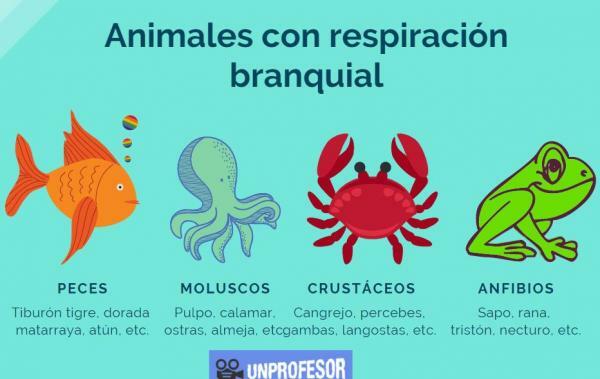
Lung respiration.
In the lung respiration, gas exchange occurs mainly In the lungs. The lungs are folds that develop in terrestrial vertebrates, from the digestive tube, and that connect with the outside through tubes of different diameter.
exist two types of lungs: saccular lungs and tubular lungs. The saccular lung, which is shaped like a sac, is typical of amphibians, reptiles and mammals, and has different degrees of evolution and specialization depending on the animal group. Other lungs are tubular in shape, and are connected with air sacs that fill with air, reducing the density of the animal; the latter are in birds.
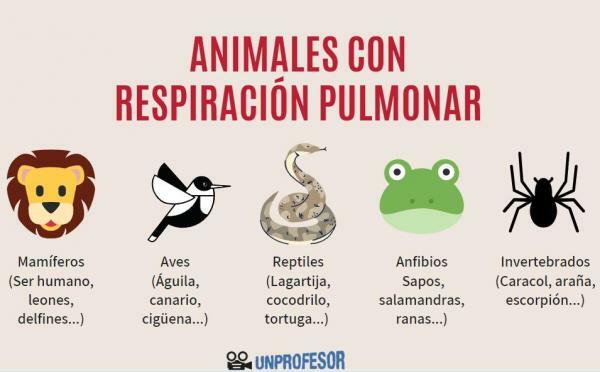
Tracheal breathing.
The tracheal breathing is one in which lung-like structures called lungs in book. These book lungs they are not true lungs, since they do not have the same embryonic origin nor are they the place where gas exchange occurs.
Animals are tracheal respiration use a tube system (tracheae), that link the cells of the whole body with the air from the outside environment. This respiratory system lacks a circulatory system that carries oxygen to the cells, so these animals are said to have an open circulatory system. In the open circulatory system, blood (hemolymph) circulates too slowly to provide enough oxygen to be efficient.
The tubes or tracheas open to the outside through holes that can be closed by spiracles.
Examples of animals with tracheal respiration
The insects and myriapods they usually present tracheal respiration and, to a lesser extent, some groups of arachnids also present this type of respiration.
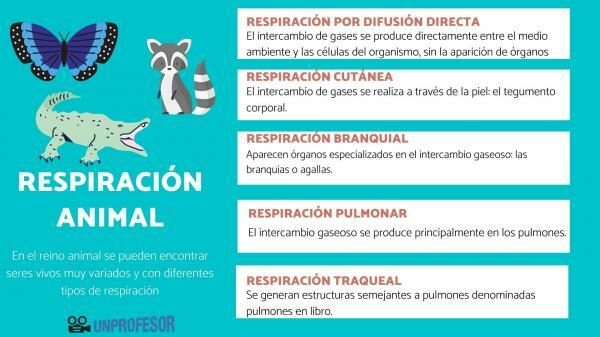
If you want to read more articles similar to Types of animal respiration, we recommend that you enter our category of biology.
Bibliography
- Sendero Vivo (s.f) Classification of animals by their breathing. Recovered from: https://senderovivo.es/clasificacion-de-los-animales-por-su-respiracion/
- Biosphere Project (s.f) Types of breathing systems. Ministry of Education. Government of Spain. Recovered from: http://recursos.cnice.mec.es/biosfera/alumno/1bachillerato/animal/contenidos7.htm
- Online teacher (s.f) Animal respiration. Recovered from: https://www.profesorenlinea.cl/Ciencias/RespiracionAnimal.htm

